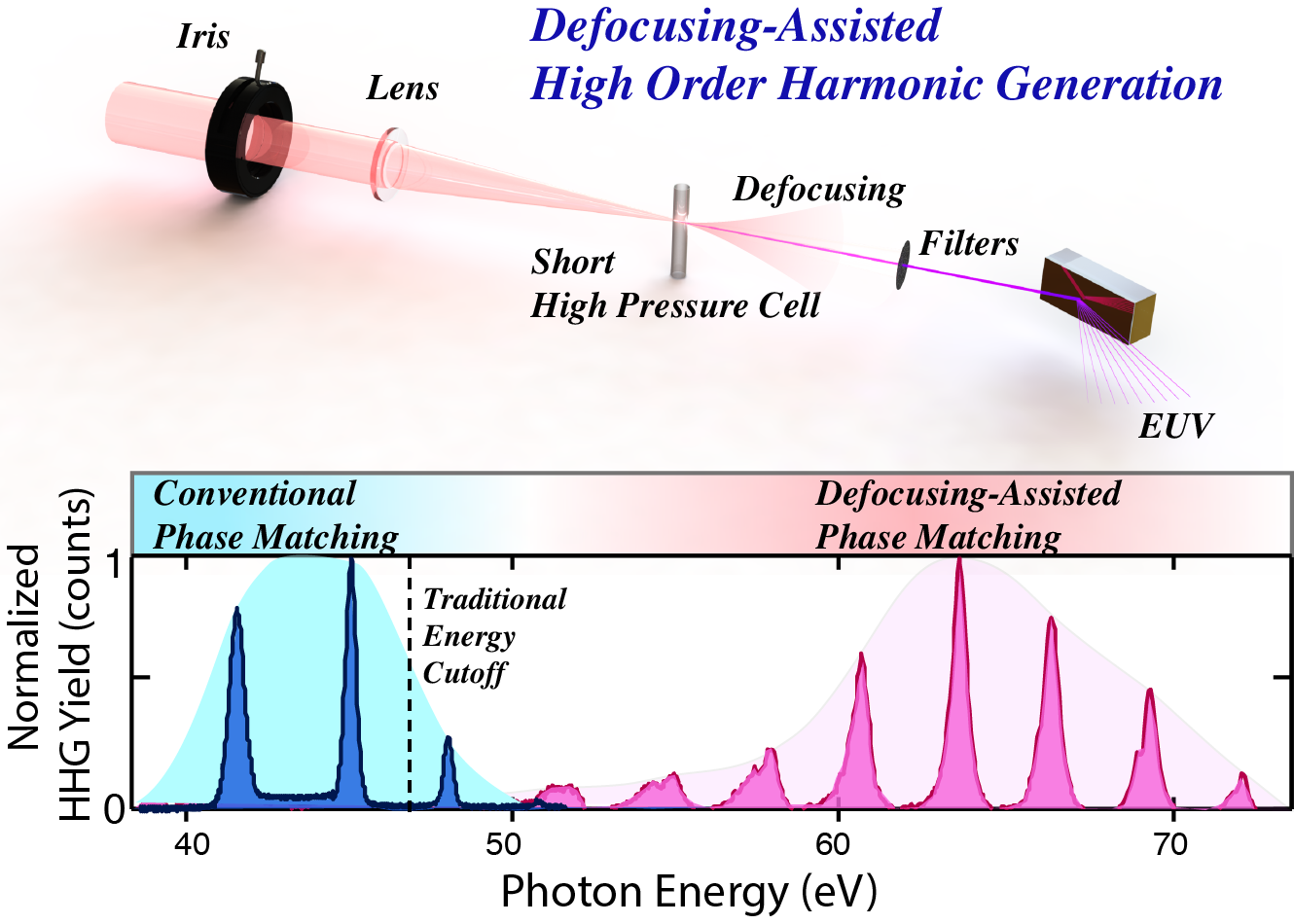

陳明彰教授團隊 ─ 一光圈突破了桌上型極紫外光產生的能量限制!

在高次諧波產生極紫外光(EUV)之過程中,較高光子能量的EUV轉換效率較低,故大多數桌上型高次諧波光源的應用僅僅限於光子能量較低的EUV。然而轉換效率低並非由於缺乏高亮度驅動雷射,而是由於難以克服諧波與驅動雷射之間相位錯位(phase-mismatch) 的問題。陳明彰教授團隊與中國南京理工大學、美國堪薩斯大學團隊合作,費時三年,解決此相位錯位的問題,全球第一次提出雷射散焦現象可補償此相位錯位,實驗上可簡單使用光圈精巧控制雷射散焦現象,調控EUV的頻寬及中心波長。此創新突破獲得光電領域國際指標期刊Optica的重視,研究成果於2017年8月刊出。
超快EUV光源近年來受到了極大的關注,特別是高次諧波產生(High harmonic generation, HHG)桌上型同調極紫外或軟X光光源。 通過將強雷射束聚焦到氣態靶中,光場游離、加速電子並引導電子撞回母原子核產生高次諧波極紫外及軟X光光源。通過這種非線性轉換的過程,提供了從飛秒(10-15 秒)至埃秒(10-18 秒)脈衝寬的EUV與軟X射線同調光源,以便能夠解析空間奈米影像、時間解析化學、材料與生物系統的超快動力學。然而,由於在高次諧波產生之過程中,較高能量的光子轉換效率較低,因此迄今為止,大多數此光源的應用僅僅用於相對低能量的EUV波長。尤其因雷射產生高次諧波的過程中,同時將氣體離子化,產生游離電子,會觸發兩個負面效應,第一個負面效應是,在時間上會導致EUV光與驅動雷射之間相位不匹配,第二個負效應是於空間上會引發雷射散焦效應–降低了雷射能量及非線性EUV轉換能力,此兩效應都使EUV光轉換效率變低。為了減低這兩個負效應(避免產生過多的游離電子),往往研究團隊不喜歡利用”緊”聚焦來產生EUV光源,因轉換效率不高。
三年前學生旆齊及宏維做實驗時,偶然發現在”緊”聚焦架構下,前面放個光圈,簡單調整光圈大小,可精巧控制高次諧波EUV的頻寬和中心波長,突破了傳統高次諧波產生能量極限,讓65eV的光強增強了四百倍,然而當時背後的原因並不是很清楚,與南京理工大學及美國堪薩斯大學研究合作,發現”適當的雷射散焦正好可彌補高次諧波產生相位不匹配的問題”,在實驗室上,可透過簡單調整光圈控制散焦效應 – 間接地校正相位匹配的問題,簡單來說,這是個美麗的巧合,就是兩個負效應其實剛好可互相彌補,達到負負得正的效果,而適當的光圈大小觸發了此巧合發生。此創新突破顯著地提升高能EUV光源的亮度,也讓其應用,譬如奈米顯影、時間解析原子、分子及材料的超快行為變得普及。
To date, the maximum photon energy that can be reached in HHG is mainly limited by phase matching problem. To overcome this limitation, many experimental and theoretical studies had been carried out in the past decade, such as Nature 421, 51(2003); Science 302, 95 (2003); Nature 433, 596 (2005); Nature Physics 3, 270 (2007); Nature Physics 3, 878 (2007); PRL 99, 053902 (2007); PNAS 106, 10516(2009); PRL 105, 173901 (2010); Nature Photonics 4, 571 (2010); PRL 104, 073901 (2010); PRL 107, 175002 (2011);Sci. Rep. 3, 1410 (2013); PRA 90, 023831 (2014), and so on. Our recent Optica work demonstrated experimentally and theoretically a new unconventional phase matching scheme: extending the HHG cutoff by controlling the rapid self-defocusing effect of the driving laser. This method takes advantage of the additional intrinsic atomic dipole phase mismatch introduced by the rapid laser defocusing. This phase can be precisely controlled by adjusting the aperture of a simple iris to correctly compensate free electron dispersion, resulting in tunable harmonic energy and cutoff extension. Our scheme is simple and robust, and the mechanism is beautifully supported by theoretical simulations. The implementation of this method in the laboratory is easy and can be extended to other targets and laser wavelengths. This new concept and scheme of phase matching will have great impact in the field of high-order harmonic generation, attosecond science and nonlinear optics.
Our new main findings include:
§ We demonstrate a working geometry, by focusing truncated beam into a short high-pressure gas cell, to extend bright coherent harmonics to a photon energy range beyond the reach of the conventional phase matching method.
§ We show theoretically that laser defocusing by the excessive ionization can help compensate the large plasma dispersion, enabling phase matching of the HHG process in plasma for the first time.
§ This new defocusing-assisted phase matching scheme has been experimentally realized by controlling the aperture size of a simple iris, resulting in the possibility of tuning and selecting harmonics as desired.
§ In the argon gas, we demonstrated that our new phase matching scheme was able to generate high harmonic emission to 65 eV, and with two orders increase in intensity to reach the theoretical absorption-limit (  photons per second). This light source has great importance for applications of probing element-selective magneto-optic dynamics.
photons per second). This light source has great importance for applications of probing element-selective magneto-optic dynamics.
Ref: Sun, H.-W., Huang, P.-C., Tzeng, Y.-H., Huang, J.-T., Lin, C. D., Jin, C., & Chen, M.-C. “Extended phase matching of high harmonic generation by plasma-induced defocusing”, Optica, 4(8), 976 (2017).
【陳明彰教授個人網頁】